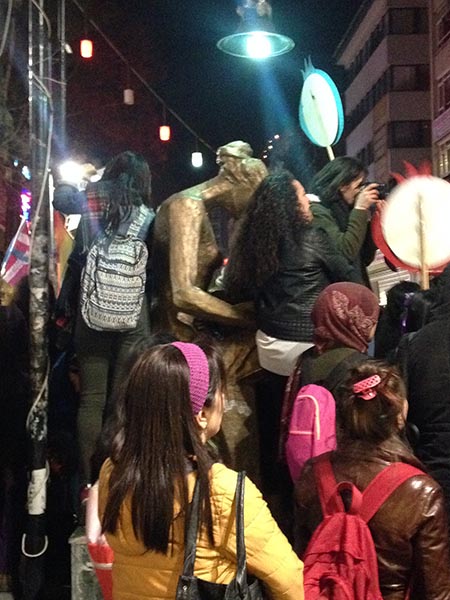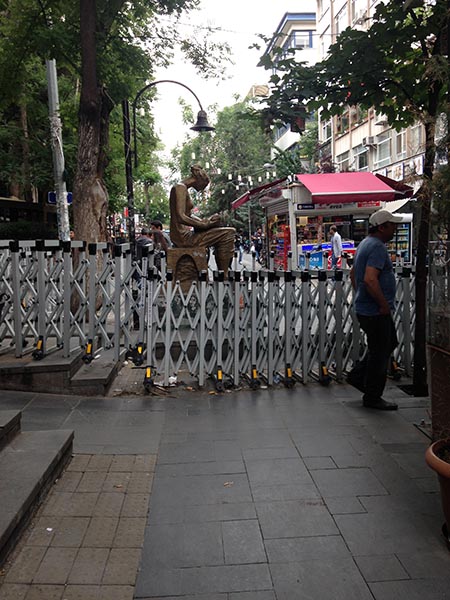
This text is an essay that was written as a proposal for KABA HAT within the scope of their guest editorship in Orta Format. I will try to interpret 2 photographs I took on Yuksel Street, in Ankara on March the 8th and June the 21st, 2017 for this issue which KABA HAT edited within the framework of the following concepts: disenchantment (1), critical skidding (2), in other words, the inability of an approach being critical to the field and inability of producing art to open a space of its own inside the present art system, and disencantada(3).
When I noticed the graffiti "Nuriye Gülmen is resisting" on the door of ODTU Library which looks out to the departments, it was December the 1st, 2016. That was the first time I heard about Nuriye and Semih who were dismissed through Decree Laws. Nuriye and Semih had beuan sit-in protest on Yuksel Street on November the 9th, 2016. On March 8 International Women's Day, I took the photograph you can find below. On the next day, on March the 9th, 2016, Nuriye and Semih began a hunger strike, and they were in their 138th day on July the 24th, 2017. As they did in their sit-in protest beginning from November the 9th, they were next to the Human Rights Sculpture on Yuksel Street. Hunger strike is a meta-narrative in sociological terms; it is surrendering one's self and body for the sake of a better and more honorable future. In this context, hunger strike is functional, and it must be considered as a democratic right. The state apparatus/political authority should also regard hunger strike as an act of civil disobedience. Yet, both modern Islam and the contemporary political Islam even reject interpreting the hunger strike as an extension of the notion of ascetism in Sufism. The fact that the practice of ascetism was excluded from Islam, impedes the acknowledgement and recognition of hunger strike as an example of civil disobedience. Both approaches overlook civil disobedience, and result in critical skidding, in other words, relations that the likes of which are found in the art world.
It is significant that the resistance began on Yuksel Street and under the Human Rights Sculpture. The sculptor of Human Rights Sculpture is also an academician like Nuriye and Semih, and following the 1980 coup d'etat, he was expelled from his position at the Faculty of Education in Gazi University with Law no. 1402. Metin Yurdanur, in a conversation he gave at the beginning of June, claimed he supported Nuriye and Semih's cause to return to their duties; and said all his sculptures are exhibited in public spaces, that he could struggle with interventions, displacements and assaults by himself within the scope of his artistic practice; but as for the police blockade of Human Rights Sculpture, the people, the public should react to it. The artist Yurdanur associated Human Rights Sculpture with a woman's figure; he made a point that the sculpture would be stylized and archaic, as well as life-size. In time, the sculpture communed with the place it stands in and its discourse. On the day I took the photograph of women celebrating March 8, the sculpture was among them, cherishing the same hope with them; but contrary to their fervor, it stood in silence. It made me feel that even an "inanimate" object can reflect a powerful existence in terms of civil disobedience, despite the fact that it was isolated in May 2017 by police barricade.
Now, when I think about that moment, what I felt was maybe what KABA HAT emphasized as re-enchantment.
I participated in the Isolation Exhibition in BörtüBöcek Gallery in Ankara on January 2017. The narrative in my work was built on the precept of ascetism; and based on the idea that one cannot be isolated against one's will, even if they do, one struggles against it. Apparently, an ideology that arrests people and their supporter families in a hunger strike, a political authority keeping a sculpture suffering since 28 years under a blockade couldn't extinguish the stars. This authority exhibited disenchantment as a social disaster; but beams of which their charms are implicit in their resistance would continue permeating from the streets of Sur and Cizre it brought down in ruins, from the neighborhoods usurped via their HDAs. Because;
"State couldn't stand, struggle against corporeal deaths…This way of dying has its own transformative and critical powers; and renders their spark alive over their convicted bodies that retreated and blacked out from the hunger strike. The other problem that one should come to terms with is perceived in mental terms. To derive from what is happening there a declaration of death's and people's power to resist, which is the embodiment of the problem, rather than some news, some protest or motto…But, this is none other than art."
(Baker, 2012; 304) (4)
The dervish calls out from the moment he hangs on
In serenity
A torment that is diligent
Is lighter than water
And heavier than hair

(1) a concept offered by Tanıl Bora in his essay Disaster dated April 26th, 2017 with a reference to Orhan Koçak's 7/24 Disaster, and Ayhan Geçgin's concept of prosaic disaster.
(2) I used it as a skidding of criticism.
(3) I used it as the Latin equivalent of disenchantment.
(4) Baker, U (2012) Dolaylı Eylem, Birikim Yayınları İstanbul(Indirect Demonstration)